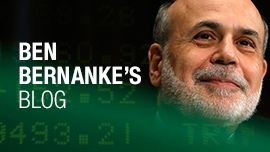China’s central banker, Zhou Xiaochuan of the People’s Bank of China (PBOC), and other top Chinese officials recently launched a communications offensive to persuade markets and foreign policymakers that no significant devaluation of the Chinese currency is planned.[1] Is the no-devaluation strategy a good one for China? If it is, what does China need to do to make its exchange-rate commitments credible?=”_ftnref1″>
The attention of global markets was focused on China’s exchange rate last August when the PBOC announced a 1.9 percent devaluation of the renminbi against the dollar, together with some changes in how the exchange rate would be set in the future. Global markets reacted poorly. Evidently, many market participants—already jittery because of the large swings in the Chinese stock market—saw the devaluation as a signal that the Chinese economy was slowing by much more than they had previously thought, and that China’s leaders had decided that a cheaper currency would boost the country’s exports.[2] Since then, the RMB has been allowed to decline another 3.6 percent against the dollar. Markets, though, seem to have come around to accepting the PBOC’s insistence that it is not pursuing a strategy of systematically devaluing the RMB. So did many of the foreign finance ministers and central bankers gathered in Shanghai for the recent meeting of the Group of 20. But, as I’ll discuss in the post, China’s ability to avoid a significant devaluation in the medium term will depend on a number of factors, including the country’s other policy choices.
China faces the classic policy trilemma of international economics, that a country cannot simultaneously have more than two of the following three: (1) a fixed exchange rate; (2) independent monetary policy; and (3) free international capital flows. Accordingly, China’s ability to manage its exchange rate may depend, among other factors, on its willingness and ability to adjust on other policy margins.
Start with four premises about the country’s current situation and its leadership’s objectives:
- China is undergoing a difficult but necessary transition from a growth model that emphasizes heavy industry, construction, and exports, to one that focuses on the development of services and greater domestic consumer demand. Observers have long understood that this shift would likely be accompanied by a slowdown in Chinese GDP growth (because the economy is more mature) and would be less predictable (because markets and entrepreneurs, rather than directions from the center, are expected to play a larger role.)
- However, China’s growth appears to have slowed recently by more than the leadership expected or wanted. This is worrisome to China’s leaders for the standard reason— the legitimacy of the government is closely tied to continued expansion of jobs and incomes—but also because the difficult process of transferring resources from shrinking sectors (manufacturing) to growing sectors (services) would be less daunting if overall growth were strong.
- To support economic growth during its difficult transition, China has eased monetary policy in various ways, recently reducing reserve requirement for banks, which allows them to lend more.
- At the same time, China has continued a process of reforming and opening up its capital markets. Notably, private Chinese citizens are allowed to invest some of their savings abroad, to a limit of $50,000 per person.
Points #3 and #4 are the sources of China’s trilemma. An economy that is growing more slowly, and in which monetary easing is the principal macroeconomic response, is not an economy that offers high returns to domestic savers.[3] Consequently, Chinese households and firms who are able to do so are spurning yuan-denominated investments and looking abroad for higher returns. However, increased private capital outflows also constitute a flight from the yuan toward the dollar and other currencies; that, in turn, puts downward pressure on China’s exchange rate.
In the short run, the PBOC can offset this pressure by selling some of its enormous stocks of dollar-denominated securities and buying yuan; indeed, Chinese reserves have fallen over $700 billion over the past year and a half. With more than $3 trillion in reserves yet remaining, China should be able to defend its exchange rate for some time. If nothing else changes, however, eventually China will run low on reserves and will no longer be willing or able to buy up yuan in the foreign-exchange market. At that point the currency would fall, probably sharply. Moreover, the risk that the yuan might be significantly devalued in the future could accelerate the decline in reserves, by leading households and firms to sell yuan now to avoid capital losses from a possible future devaluation. Here is the trilemma in action: If China wants to use monetary policy to manage domestic demand and to simultaneously free up international capital flows, it may not be able to fix the exchange rate at current levels.
How can China resolve these conflicts? One approach would be to devalue now and get it over with. (A series of small devaluations wouldn’t work, as expectations of future devaluations would just accelerate capital outflows.) If the devaluation were sufficiently large that no further declines in the currency were expected, then the pressure on China’s reserves would end and the exchange rate would presumably settle into a new equilibrium. Despite the appealing simplicity of this solution, however, in the current global environment, a large Chinese devaluation would likely be counterproductive. With many emerging-market economies already weakening and under financial stress, and with monetary policy in advanced industrial economies hobbled by the zero lower bound on interest rates, a big yuan devaluation would likely be deflationary for the rest of the world. (Indeed, fairly or not, a devaluing China could face accusations of waging a “currency war,” that is, weakening its currency to “steal” exports and aggregate demand from other countries.) The hit to the global economy and financial markets would in turn likely lead, counterproductively, to slower growth in China. Moreover, devaluation—by advantaging traded goods over nontraded goods—would work against the goal of promoting services over exports.
A second possibility for China would be to stop or reverse the process of liberalizing capital flows, making it more difficult for Chinese households and businesses to invest outside the country. This approach has received some support from Christine Lagarde, managing director of the IMF, and Haruhiko Kuroda, governor of the Bank of Japan, and I would not be surprised to see some steps in this direction. By slowing capital outflows, restrictions on out-bound foreign investment would mitigate the pressure on China’s official reserves and on the exchange rate.
This strategy also has problems, however: It would sacrifice some of the progress that China has made in opening up its financial system—which is itself a prerequisite for achieving China’s goal of making the renminbi an international reserve currency. Moreover, the horse may be out of the proverbial barn, in that the effectiveness of new capital controls in China would be uncertain. So long as China maintains its openness to trade and inward investment, there are potentially many ways for households and firms to evade restrictions on capital outflows. For example, an exporting firm might under-invoice its sales, investing the unreported foreign currency receipts. Capital controls simply might not work.
A third option is to wait and hope that growth returns, obviating the need for easy monetary policy. However, hope is not a plan.
So what to do? An alternative worth exploring is targeted fiscal policy, by which I mean government spending and tax measures aimed specifically at aiding the transition in China’s growth model. (Spending on traditional infrastructure like roads and bridges is not what I have in mind; in the Chinese context, that’s part of the old growth model.) For example, as China observers have noted, the lack of a strong social safety net—the fact that Chinese citizens are mostly on their own when it comes to covering costs of health care, education, and retirement—is an important motivation for China’s extraordinarily high household saving rate. Fiscal policies aimed at increasing income security, such as strengthening the pension system, would help to promote consumer confidence and consumer spending. Likewise, tax cuts or credits could be used to enhance households’ disposable income, and government-financed training and relocation programs could help workers transition from slowing to expanding sectors. Whether subsidies to services industries are appropriate would need to be studied; but certainly, unwinding existing subsidies to heavy industry and state-owned enterprises, together with efforts to promote entrepreneurship and a more-level playing field, would be constructive.
There are recent indications China might be moving this direction. On Saturday, Premier Li Keqiang noted the budget deficit target for 2016 would be 3.0%, an increase from 2.3% in 2015. Mr. Li also spoke about using “mergers, reorganizations, debt restructuring and bankruptcy liquidations” to deal with “zombie enterprises”—failing state-owned enterprises supported by government assistance—and added that the government will spend $15.3 billion to help those laid off as a result. Further fiscal reform measures were announced on Monday.
Targeted fiscal action has a lot to recommend it, given China’s trilemma. Unlike monetary easing, which works by lowering domestic interest rates, fiscal policy can support aggregate demand and near-term growth without creating an incentive for capital to flow out of the country. At the same time, killing two birds with one stone, a targeted fiscal approach would also serve the goals of reform and rebalancing the economy in the longer term. Thus, in this way China could effectively pursue both its short-term and longer-term objectives without placing downward pressure on the currency and without new restrictions on capital flows. It’s an approach that China should consider.
[1] China has indicated that they intend to guide the value of the currency with reference to a basket of foreign currencies, rather than tying the yuan only to the U.S. dollar as in the past. In this post, “significant devaluation” means a sharp reduction of the value of the yuan against both the dollar and other major currencies.
[2] For a fuller account, see page 29 of Eswar Prasad’s recent report, “China’s Efforts to Expand the International Use of the Renminbi.”
[3] Historically, financial repression in China, such as ceilings on deposit rates, has limited investment opportunities for domestic savers, though some of these limits have been removed recently. See “China’s Central Bank Lifts Ceiling on Long-Term Deposit Rates.” The government’s anti-corruption campaign has also motivated some Chinese to move funds abroad.
Comments are now closed for this post.
The Brookings Institution is committed to quality, independence, and impact.
We are supported by a diverse array of funders. In line with our values and policies, each Brookings publication represents the sole views of its author(s).




Commentary
China’s trilemma—and a possible solution
March 9, 2016